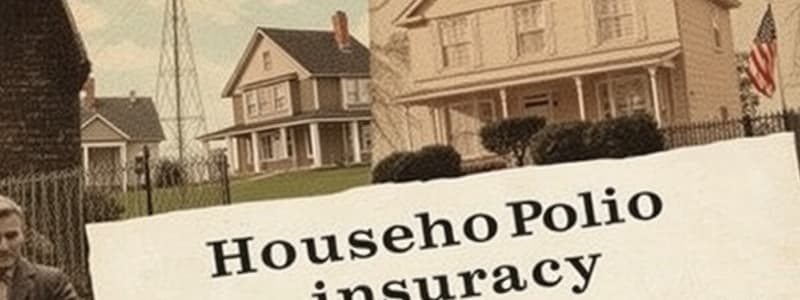Podcast
Questions and Answers
A homeowner's building is damaged by a covered peril. The homeowner chooses not to reinstate (rebuild) the property. How will the claim typically be settled?
A homeowner's building is damaged by a covered peril. The homeowner chooses not to reinstate (rebuild) the property. How will the claim typically be settled?
- Based on the reinstatement value, with no deduction for wear and tear, regardless of whether reinstatement occurs.
- On a normal indemnity basis, with a deduction for depreciation. (correct)
- Based on the cost of a new building, regardless of the original building's age or condition.
- The insurer is not obligated to pay anything, as the homeowner did not reinstate the property.
A homeowner has a household insurance policy with an 85% condition of average for the building. The building is insured for $500,000, but its actual reinstatement value is $600,000. A fire causes $100,000 in damage. How much will the insurance company likely pay?
A homeowner has a household insurance policy with an 85% condition of average for the building. The building is insured for $500,000, but its actual reinstatement value is $600,000. A fire causes $100,000 in damage. How much will the insurance company likely pay?
- $100,000
- $83,333 (correct)
- $115,000
- $85,000
Which of the following scenarios is LEAST likely to be covered under the 'Contents' section of a standard household insurance policy?
Which of the following scenarios is LEAST likely to be covered under the 'Contents' section of a standard household insurance policy?
- Water damage to furniture caused by a burst pipe.
- Fire damage to clothing and personal items.
- Theft of jewelry from the insured's home, with evidence of forced entry.
- Damage to a laptop used primarily for the insured's home-based business. (correct)
Which of the following perils is typically included in a standard household insurance policy?
Which of the following perils is typically included in a standard household insurance policy?
A tree on your property falls during a windstorm, damaging your roof. The policy covers damage by falling trees. Which of the following costs would likely be covered by your homeowner's insurance?
A tree on your property falls during a windstorm, damaging your roof. The policy covers damage by falling trees. Which of the following costs would likely be covered by your homeowner's insurance?
What is the meaning of 'theft' as it is typically defined in a household insurance policy?
What is the meaning of 'theft' as it is typically defined in a household insurance policy?
Under what circumstances would smoke damage typically NOT be covered by a standard household insurance policy?
Under what circumstances would smoke damage typically NOT be covered by a standard household insurance policy?
An insured's home contents are covered for temporary removal up to 15% of the sum insured. Which scenario would NOT be covered under this provision?
An insured's home contents are covered for temporary removal up to 15% of the sum insured. Which scenario would NOT be covered under this provision?
A homeowner has an 'all risks' policy on valuable jewelry. Which of the following scenarios is MOST likely to be excluded?
A homeowner has an 'all risks' policy on valuable jewelry. Which of the following scenarios is MOST likely to be excluded?
A homeowner has a household policy with public liability coverage. A visitor trips on a loose step and injures themselves. What factor would MOST likely cause the insurance company to deny the claim?
A homeowner has a household policy with public liability coverage. A visitor trips on a loose step and injures themselves. What factor would MOST likely cause the insurance company to deny the claim?
An insured has a household contents policy on a 'new for old' basis. During a fire, a five-year-old television is destroyed. How will the claim be settled?
An insured has a household contents policy on a 'new for old' basis. During a fire, a five-year-old television is destroyed. How will the claim be settled?
A homeowner employs a full-time housekeeper. Which type of liability coverage in a standard household policy would MOST likely cover injuries sustained by the housekeeper while on the job?
A homeowner employs a full-time housekeeper. Which type of liability coverage in a standard household policy would MOST likely cover injuries sustained by the housekeeper while on the job?
An insured fails to insure their contents for the full replacement value. In the event of a claim, how will this impact the settlement?
An insured fails to insure their contents for the full replacement value. In the event of a claim, how will this impact the settlement?
Which of the following factors related to the insured property would MOST likely lead an insurer to increase the premium for a household policy?
Which of the following factors related to the insured property would MOST likely lead an insurer to increase the premium for a household policy?
A homeowner’s policy includes coverage for damage to the building containing the contents. What type of expense would this coverage MOST likely address?
A homeowner’s policy includes coverage for damage to the building containing the contents. What type of expense would this coverage MOST likely address?
A homeowner's policy includes compensation for the death of the insured by burglars. Which of the following scenarios would MOST likely be covered by this provision?
A homeowner's policy includes compensation for the death of the insured by burglars. Which of the following scenarios would MOST likely be covered by this provision?
An insured renovates their home, which involves some electrical work. Later damage occurs to the jewelry 'all risk' policy. Which exclusion would most likely apply?
An insured renovates their home, which involves some electrical work. Later damage occurs to the jewelry 'all risk' policy. Which exclusion would most likely apply?
Flashcards
Household Policy
Household Policy
Coverage for a wide array of risks, such as fire, theft and natural disasters.
Common Insured Peril: Fire
Common Insured Peril: Fire
Fire, lightning, explosion.
Common Insured Peril: Nature
Common Insured Peril: Nature
Hurricane, earthquake, volcanic eruption.
Common Insured Peril: Civil Unrest
Common Insured Peril: Civil Unrest
Signup and view all the flashcards
Buildings Cover
Buildings Cover
Signup and view all the flashcards
Architect's Fees Coverage
Architect's Fees Coverage
Signup and view all the flashcards
Debris Removal Coverage
Debris Removal Coverage
Signup and view all the flashcards
Contents Cover
Contents Cover
Signup and view all the flashcards
Contents Cover Extensions
Contents Cover Extensions
Signup and view all the flashcards
'New for Old' Basis
'New for Old' Basis
Signup and view all the flashcards
Full Replacement Value
Full Replacement Value
Signup and view all the flashcards
'All Risks' Coverage
'All Risks' Coverage
Signup and view all the flashcards
'All Risks' Exclusions
'All Risks' Exclusions
Signup and view all the flashcards
Public Liability
Public Liability
Signup and view all the flashcards
Personal Liability
Personal Liability
Signup and view all the flashcards
Workmen's Compensation
Workmen's Compensation
Signup and view all the flashcards
Underwriting Factors
Underwriting Factors
Signup and view all the flashcards
Additional Underwriting Factors
Additional Underwriting Factors
Signup and view all the flashcards
Study Notes
- A household policy provides wide-ranging coverage for various perils.
Insured Perils
- Fire, lightning, and explosion are typically covered.
- Natural disasters like hurricanes, earthquakes, and volcanic eruptions are included.
- Coverage extends to flood damage.
- Theft, including larceny, is generally covered, even without forced entry.
- Protection against riot, strike, and malicious damage is provided.
- Damage from bursting or overflowing water tanks and pipes is covered.
- Impact from vehicles, aircraft, or aerial devices is an insured peril.
- Damage due to breakage or collapse of TV or radio antennas is included.
- Some policies cover collapse from subsidence or landslip.
- Smoke damage is covered if sudden, unusual, and accidental.
- Damage from falling trees or parts is sometimes included.
Property Risks Covered: Buildings
- Covers loss or damage to the insured's private dwelling from insured perils.
- Includes architects' and surveyors' fees for replacing damaged buildings.
- Covers the costs of removing debris after damage from an insured peril.
- Covers accidental breakage of fixed glass and sanitary fixtures up to a policy limit.
- Loss of rent incurred due to damage from an insured peril is covered, up to a percentage of the building's insured value.
- Buildings can be insured on a reinstatement basis, covering the cost of replacement with new property of the same kind, without deducting for wear and tear.
- An 85% condition of average applies to reinstatement.
- If the insured doesn't reinstate, the claim is settled on an indemnity basis, deducting depreciation.
Property Risks Covered: Contents
- Covers loss or damage to household goods and personal effects from insured perils.
- Insurers usually need details for electronics and a valuation for jewelry.
- Property used for business is not covered.
- Temporary removal of contents is covered, up to 15% of the contents' insured value.
- Accidental breakage of mirrors and glass is included.
- Servants' goods not otherwise insured are covered.
- Covers rent or additional expenses if the building containing the insured contents is damaged.
- Compensation for the death of the insured or spouse by burglars or fire is provided, limited to $5,000 or half the contents' insured value, whichever is less.
- Contents are insured on a 'new for old' basis, without deducting for wear and tear, except for clothing and household linen.
- The insured value must represent the full replacement value of the contents, or depreciation is factored into claims.
All Risks on Contents
- Certain valuables, like jewelry, can be covered on an 'all risks' basis.
- The extent of cover is wider than named insured perils, covering any cause not specifically excluded.
- It may apply beyond the home, potentially covering items anywhere in Trinidad and Tobago, the West Indies, or worldwide.
- Exclusions include loss or damage from atmospheric conditions, wear and tear, renovation processes, or mechanical/electrical issues.
- Theft of jewelry from baggage is excluded unless carried by hand by the insured or family member.
- Theft from unattended hotel rooms is also excluded.
Liability Risks Covered: Public Liability
- Protects against sums the insured is legally liable to pay as owner/occupier for accidents on the premises causing death, injury, or property damage to third parties.
- Excludes liability for business risks.
Liability Risks Covered: Personal Liability
- Indemnifies the insured or resident family member against sums legally liable to pay as a private individual for accidents in Trinidad and Tobago causing death, injury, or property damage.
- Excludes liability for business risks and motor vehicle accidents.
Liability Risks Covered: Workmen’s Compensation
- Covers the insured's legal liability for injury to domestic servants during employment.
- Liability may arise under the Workmen’s Compensation Act or common law.
- Excludes servants with casual employment.
Underwriting Factors
- Factors considered for household policy underwriting include:
- Property situation
- Insured's/spouse's profession or occupation
- Building's age and construction
- Building's state of repair
- Special exposure to insured perils
- Age, construction, and occupation of nearby buildings
- Likely unoccupancy periods
- Use of property other than residential
- Insurance history
- Claims/losses history
Studying That Suits You
Use AI to generate personalized quizzes and flashcards to suit your learning preferences.
Description
Covers a wide range of perils, including fire, natural disasters, theft, and water damage. Buildings are protected against various risks. This also includes architects' and surveyors' fees for replacing damaged property.




